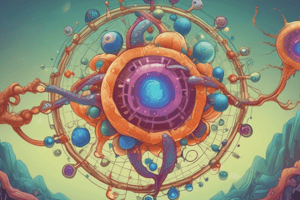Podcast
Questions and Answers
What is a key characteristic of prokaryotic cells?
What is a key characteristic of prokaryotic cells?
- Use DNA for energy storage
- Have a complex structure
- Lack membrane-bound organelles (correct)
- Contain a nucleus
What is the first step in gene expression?
What is the first step in gene expression?
- Translation
- Transcription (correct)
- Replication
- Translocation
What does natural selection explain in the context of evolution?
What does natural selection explain in the context of evolution?
- Organisms better adapted to their environment tend to survive (correct)
- Only the strongest organisms survive
- Evolution occurs randomly without influence
- All species are created equally
Which of the following is NOT considered a component of an ecosystem?
Which of the following is NOT considered a component of an ecosystem?
What are carbohydrates primarily used for in living organisms?
What are carbohydrates primarily used for in living organisms?
What is homeostasis?
What is homeostasis?
Which of the following best describes genetic engineering?
Which of the following best describes genetic engineering?
What type of microorganisms can cause diseases?
What type of microorganisms can cause diseases?
Flashcards are hidden until you start studying
Study Notes
Cell Biology
-
Cell Theory:
- All living organisms are composed of cells.
- The cell is the basic unit of life.
- All cells arise from pre-existing cells.
-
Cell Structure:
- Prokaryotic Cells: Lack a nucleus and membrane-bound organelles (e.g., bacteria).
- Eukaryotic Cells: Contain a nucleus and organelles (e.g., plants, animals).
Genetics
-
DNA Structure:
- Double helix formed by nucleotides (adenine, thymine, cytosine, guanine).
-
Gene Expression:
- Transcription: DNA to RNA.
- Translation: RNA to protein.
-
Mendelian Genetics:
- Traits are inherited according to dominant and recessive alleles.
- Key concepts include homozygous, heterozygous, genotype, and phenotype.
Evolution
-
Natural Selection:
- Mechanism of evolution where individuals better adapted to their environment tend to survive and reproduce.
-
Common Descent:
- All living organisms share a common ancestor.
-
Speciation:
- The formation of new and distinct species during the course of evolution.
Ecology
-
Ecosystem Components:
- Biotic (living organisms) and abiotic (non-living factors) components.
-
Energy Flow:
- Energy flows through an ecosystem via food chains and food webs, from producers to consumers and decomposers.
-
Population Dynamics:
- Factors influencing population size: birth rate, death rate, immigration, emigration.
Biochemistry
- Macromolecules:
- Carbohydrates: Provide energy (e.g., sugars, starch).
- Proteins: Made of amino acids, function as enzymes, structural components.
- Lipids: Fats and oils, important for membranes and energy storage.
- Nucleic Acids: DNA and RNA, store and transmit genetic information.
Physiology
-
Homeostasis:
- Maintenance of a stable internal environment (e.g., temperature, pH).
-
Organ Systems:
- Major systems include circulatory, respiratory, digestive, nervous, and endocrine.
Biotechnology
-
Genetic Engineering:
- Manipulation of an organism's DNA (e.g., CRISPR technology).
-
Cloning:
- Producing a genetically identical copy of an organism.
-
Stem Cells:
- Undifferentiated cells capable of developing into different cell types.
Microbiology
-
Microorganisms:
- Includes bacteria, viruses, fungi, and protozoa.
-
Pathogens:
- Microorganisms that can cause disease.
-
Antibiotics:
- Medications that inhibit bacterial growth or kill bacteria.
Plants and Animals
-
Plant Structure:
- Key parts: roots, stems, leaves (photosynthesis).
-
Animal Behavior:
- Responses to environmental stimuli, including innate and learned behaviors.
This overview encompasses various fundamental principles and areas of study within biology.
Cell Theory
- All living organisms are made up of one or more cells
- The cell is the fundamental unit of life
- All cells arise from pre-existing cells
Prokaryotic Cells
- Lack a nucleus
- Lack membrane-bound organelles
- Examples: bacteria
Eukaryotic Cells
- Have a nucleus
- Have membrane-bound organelles
- Examples: plants, animals
DNA Structure
- Double helix
- Composed of nucleotides: adenine, thymine, cytosine, guanine
Gene Expression
- Transcription: DNA is transcribed into RNA
- Translation: RNA is translated into protein
Mendelian Genetics
- Traits are inherited based on dominant and recessive alleles
- Key concepts include: homozygous, heterozygous, genotype, phenotype
Natural Selection
- Individuals better adapted to their environment survive and reproduce more successfully
Common Descent
- All living organisms share a common ancestor
Speciation
- Formation of new, distinct species during evolution.
Ecosystem Components
- Biotic: Living organisms (e.g., plants, animals, bacteria)
- Abiotic: Non-living factors (e.g., temperature, water, sunlight)
Energy Flow
- Flows through an ecosystem via food chains and food webs
- Energy is transferred from producers to consumers to decomposers
Population Dynamics
- Factors influencing population size: birth rate, death rate, immigration, emigration.
Macromolecules
- Carbohydrates: Provide energy (e.g., sugars, starch)
- Proteins: Made of amino acids, function as enzymes, structural components
- Lipids: Fats and oils, important for membranes and energy storage
- Nucleic Acids: DNA and RNA, store and transmit genetic information.
Homeostasis
- Maintenance of a stable internal environment (e.g., temperature, pH)
Organ Systems
- Major systems include circulatory, respiratory, digestive, nervous, and endocrine.
Genetic Engineering
- Manipulation of an organism's DNA (e.g., CRISPR technology)
Cloning
- Producing a genetically identical copy of an organism
Stem Cells
- Undifferentiated cells capable of developing into different cell types
Microorganisms
- Include bacteria, viruses, fungi, and protozoa
Pathogens
- Microorganisms that can cause disease
Antibiotics
- Medications that inhibit bacterial growth or kill bacteria.
Plant Structure
- Key parts: roots, stems, leaves (photosynthesis)
Animal Behavior
- Responses to environmental stimuli, including innate and learned behaviors.
Studying That Suits You
Use AI to generate personalized quizzes and flashcards to suit your learning preferences.




